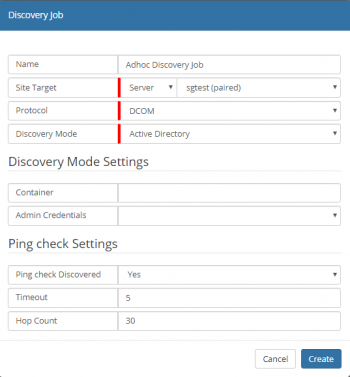Difference between revisions of "Template:ITOM Discovery Job Properties"
Jump to navigation
Jump to search
| Line 3: | Line 3: | ||
{{Bullet1|Site Target [Group / Server ]|whether the job needs to run on an SIS Group or on a single SIS/Managed CI}} | {{Bullet1|Site Target [Group / Server ]|whether the job needs to run on an SIS Group or on a single SIS/Managed CI}} | ||
<div class="mw-collapsible mw-collapsed" data-collapsetext="Show Less" data-expandtext="Read More" style="width:1000px"> | <div class="mw-collapsible mw-collapsed" data-collapsetext="Show Less" data-expandtext="Read More" style="width:1000px"> | ||
| − | {{Bullet1|Protocol|A device is identified as discovered once it can be accessed and its inventory retrieved. This is achieved by probing its Operating System (OS) using various methods dependant on the devices Operating System. The probe will | + | {{Bullet1|Protocol|A device is identified as discovered once it can be accessed and its inventory retrieved. This is achieved by probing its Operating System (OS) using various methods dependant on the devices Operating System. The probe will be initiated from the SIS server and does not require any software to be uploaded to the device. In order to achieve this, a protocol will be required in order for the SIS to access the device. Which protocol will depend on the OS and what is supported, in general for Windows devices WMI is used along with DCOM or WinRM, and for Linux / Unix (inc Apple Mac) Secure Shell (SSH) is used.}} |
| − | |||
| − | |||
<div class="mw-collapsible-content"> | <div class="mw-collapsible-content"> | ||
| + | {{Bullet2|Auto|}} | ||
{{Bullet2|WinRm|Provides secure and firewall-friendly communications, in order to access WMI. This feature is supported on Windows 2008R2 and later and Windows 7 and later.}} | {{Bullet2|WinRm|Provides secure and firewall-friendly communications, in order to access WMI. This feature is supported on Windows 2008R2 and later and Windows 7 and later.}} | ||
| − | {{Bullet2|DCOM|Communication relies on Remote Procedure Calls and can be tricky to configure over firewalls. | + | {{Bullet2|DCOM|Communication relies on Remote Procedure Calls and can be tricky to configure over firewalls. Widely supported on the Windows platform, this protocol is mainly used to access legacy devices. } |
| − | {{Bullet2|SSH|Secure Shell is a network communication protocol that allows for remote connection between two computers to communicate and share data, commonly used but not exclusively by Unix | + | {{Bullet2|SSH|Secure Shell is a network communication protocol that allows for remote connection between two computers to communicate and share data, commonly used but not exclusively by Linux / Unix (inc Apple Mac) devices. The protocol can be used on Windows devices, but may require additional software to be installed and configured.}} |
</div> | </div> | ||
</div> | </div> | ||
Revision as of 19:46, 18 November 2020
- Name
- Name given to identify this Discovery Job
- Site Target [Group / Server ]
- whether the job needs to run on an SIS Group or on a single SIS/Managed CI
- Protocol
- A device is identified as discovered once it can be accessed and its inventory retrieved. This is achieved by probing its Operating System (OS) using various methods dependant on the devices Operating System. The probe will be initiated from the SIS server and does not require any software to be uploaded to the device. In order to achieve this, a protocol will be required in order for the SIS to access the device. Which protocol will depend on the OS and what is supported, in general for Windows devices WMI is used along with DCOM or WinRM, and for Linux / Unix (inc Apple Mac) Secure Shell (SSH) is used.
- Auto
- WinRm
- Provides secure and firewall-friendly communications, in order to access WMI. This feature is supported on Windows 2008R2 and later and Windows 7 and later.
{{Bullet2|DCOM|Communication relies on Remote Procedure Calls and can be tricky to configure over firewalls. Widely supported on the Windows platform, this protocol is mainly used to access legacy devices. }
- SSH
- Secure Shell is a network communication protocol that allows for remote connection between two computers to communicate and share data, commonly used but not exclusively by Linux / Unix (inc Apple Mac) devices. The protocol can be used on Windows devices, but may require additional software to be installed and configured.
- Discovery Mode
- The Discover Mode dictates the method that identifies devices on the Network. Each Mode will have specific settings; these will be visible in the Discover Mode Settings. It is only possible to have a single mode per Job use of multiple modes, will require the creation of multiple Jobs.
- Ping Check Settings
- Ping check Discovered
- [Yes / No] Check that the discovered machine is pinged - if ICMP is disabled or firewalled, then select "No"
- Timeout
- Hop Count
